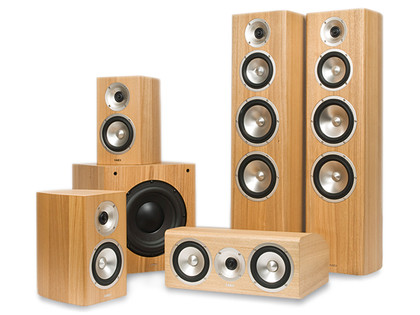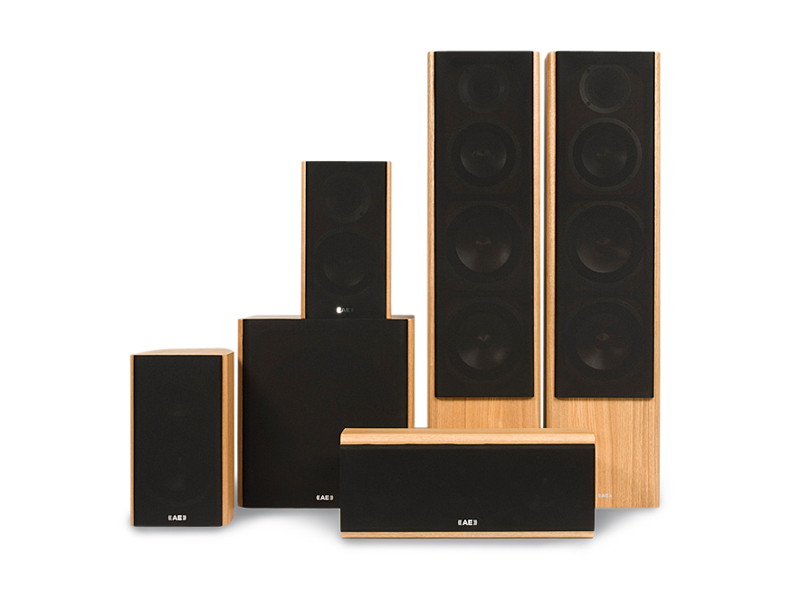TechRadar Verdict
This is simply an awesome speaker package with good sound and the looks to match
Pros
- +
Huge scale and volume
- +
Plenty of treble detail
- +
Ample bass weight from the front speakers
Cons
- -
Subwoofer is a little lacklustre
- -
Could be a more open mid-range
Why you can trust TechRadar
With the Radiance lineup, Acoustic Energy is using its 25 years' of knowledge of traditional wooden cabinets and alloy drive units, and transplanting it into some attractively tapered boxes.
It's not just the curved enclosure that's new; AE has spent three years developing the Radiance series and says that it's the company's most radical rethink so far. So what, exactly, has the Cirencester-based design team come up with?
Top of the range
The Radiance range includes some middle-of-the-road two-way floorstanders called Radiance Two, but our 5.1 configuration is comprised of the flagship three-way Radiance Three towers, a very substantial centre channel and a pair of fairly chunky bookshelf speakers for the rears. A front-firing active subwoofer takes care of the very low end.
All the cabinets are made from 15mm MDF panels with a carefully applied and not unattractive real wood veneer. As usual, you can choose your finish to suit your furniture. That's assuming you still have room for any – these cabinets are pretty large.
The massive front speakers (almost a metre high) come with wide outrigger platform bases that stand on spiked feet. They look a bit like corrective shoes, but the combined weight of the cabinet and base acts as an effective anchor. The size advantage also means there's ample room within the enclosure to generate a hearty low-end.
You can further tune the cabinets by blocking, or obscuring, the rear ports. There are three of these on each of the Radiance Threes – one for each internal compartment. Push them back against the wall to load the bass, or pull them forwards if it's already booming.
Sign up for breaking news, reviews, opinion, top tech deals, and more.
Meanwhile, the curved shape of the enclosure avoids the build up of interior standing waves, so between them, you already get a powerful and throaty sound from the front. Add in the big, rounded centre channel and you have quite an intimidating front soundstage, with an arsenal of metal dome tweeters pointing at you.

ALUMINIUM HEAVEN: The rigid aluminium dome drivers help deliver a clean, revealing sound
To get the best performance from it, you'll need a rigid speaker stand to keep the centre speaker in line with the front pair. The rears can be wall mounted if you can find a sturdy enough bracket, while the squat sub can lurk anywhere in the room.
Big boxes like the Radiance series usually require big amplification, but these are actually quite sensitive at 88dB and 90dB, and a moderately powerful Marantz SR-6003 proved enough to drive them pretty hard.
I got the best results by using the spare pair of amplifiers in the Marantz to bi-amp the two Radiance Threes and give them an additional energy boost. In fact, tri-wiring is an option if you care to add another stereo amplifier.
With the extra power and a feisty surround soundtrack (in this case the 5.1 DTS-HD Master Audio mix on the Valkyrie Blu-ray disc) these speakers can really come to life.
High-frequency stunner
You might expect the bass to be a little overwhelming in a modestly sized room (especially with the subwoofer set to stun), but it's the biting treble that actually makes the bigger impact.
This clarity in the high frequencies is a real advantage with dialogue, and the Radiance Centre delivers astonishingly crisp vocals through the confusion of the noisy but brief battle scene in Chapter Two of the Valkyrie disc.
The accurate top-end also nicely punctuates the artillery fire as it zips across the soundstage. In fact, this scene has some of the best surround steering I've come across, and if the Radiance rears didn't tonally match the front three speakers, the handover of effects wouldn't work nearly as well as it does here.
The mid-band sounds spacious, too; you'll notice this with the crisp echo of Tom Cruise's jack boots marching along corridors. The AEs convey a good sense of the interior ambiences.
Bass matters
The five Radiance speakers work well as a team to provide a surprisingly punchy and dynamic sound on all sides, while the subwoofer does a reasonable job with the bass channel. If there is a weak link though, it's the sub, which leaves the bottom-end sounding slightly underwhelming given the amount of sound system in the room.
Swapping movies for music for a moment reveals that the Radiance Threes already generate a very wide dynamic range, reaching right down to 27Hz in stereo mode without the need for a sub.
The front pair on their own put in a rousing musical two-channel performance; given Neil Young's live Road Rock DVD-Audio disc, which has both stereo and 5.1 mixes, it's the stereo track that impresses the most. It sounds just as open and creates a perfect stereo image in front. Neil's nasal tones are clear and you can hear every scratch of his fingers on the guitar strings.
What's more, the rear speakers, which are often sold as a stereo pair in a hi-fi setup, sound equally musical when I experimented with wiring these up at the front. So in a surround setup you'll really benefit from their sensitivity to fine detail and excellent handling of musical scores.
It seems, then, that what the Radiance collective does best is put forward a clean and revealing sound that's actually much leaner than their stable mates at Acoustic Energy, the Aelites.
While the more affordable Aelite speakers produced a lush warm sound from their equally large wooden cabinets, their soft dome tweeters are no match for the crunchingly accurate alloy tweeters of the Radiance crew.
My advice would be to audition the Radiance range if you prefer a more revealing sound as opposed to a warmer, more bass-driven tone and make sure you have plenty of room to move these speakers around as their placement is critical.
Partnered with a decent and fairly powerful amp, these hefty pieces of wood will drive a big cinema room effortless, and without missing the fine detail.
Follow TechRadar Reviews on Twitter: http://twitter.com/techradarreview

Jim has been evaluating printers for more than twenty years and has, to date, written over a hundred reviews for TechRadar Pro. From pocket printers to industrial dye sublimation, Jim has been there, run the tests and printed the t-shirt. His expertise extends to consumables (paper, ink, toner) and his printer buying guides make it easy to compare these essential peripherals.
